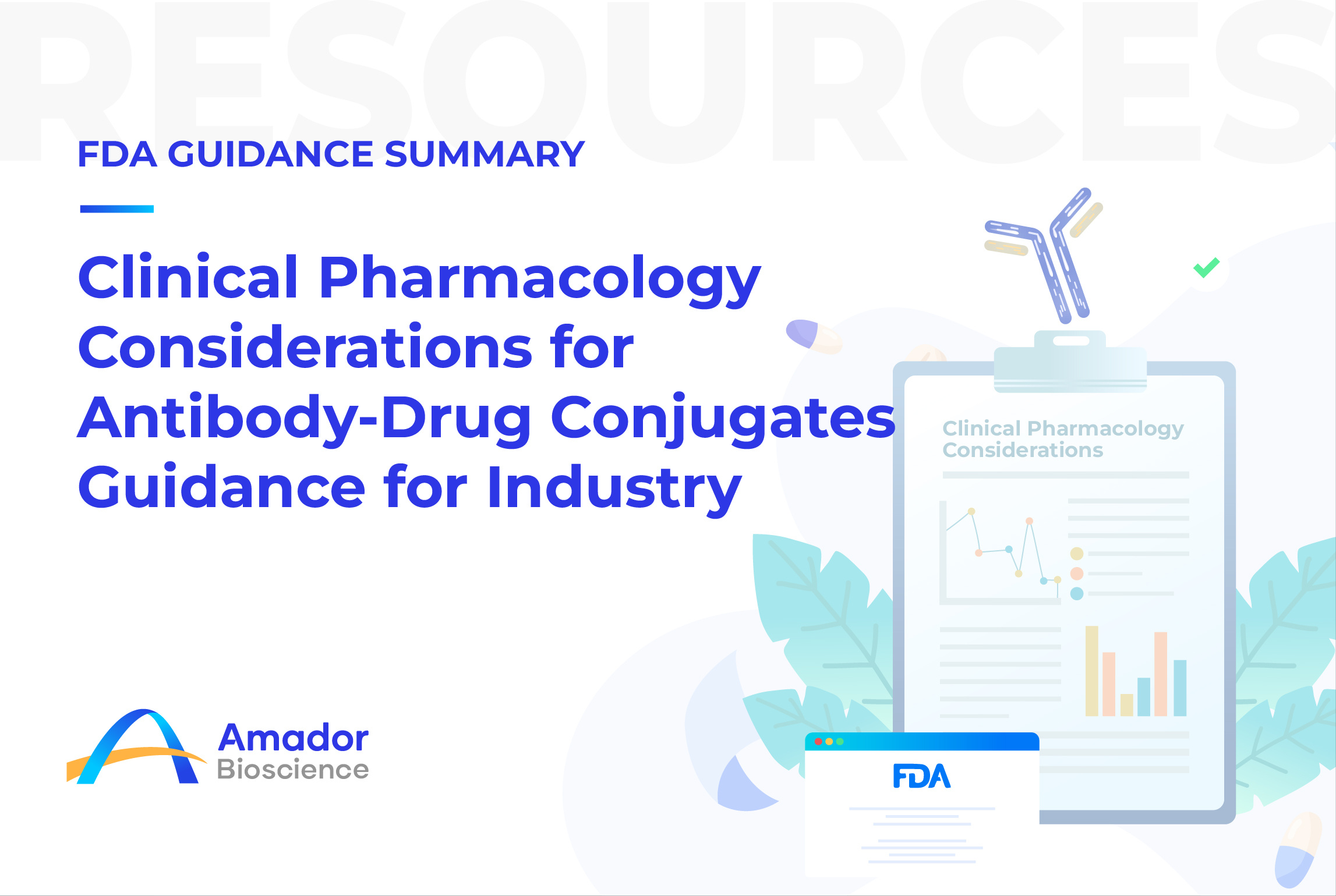Clinical Pharmacology Considerations for ADC Guidance for Industry
This guidance issued on March 2024 provides recommendations to assist industry and other parties involved in the development of ADCs. Specifically, this guidance addresses the FDA’s current thinking regarding clinical pharmacology considerations and recommendations for bioanalytical methods, dosing strategies, dose- and exposure-response analysis, intrinsic factors, QTc assessments, immunogenicity, and DDIs.
 \
\
Ⅰ. Introduction
This guidance issued on March 2024 provides recommendations to assist industry and other parties involved in the development of ADCs. Specifically, this guidance addresses the FDA’s current thinking regarding clinical pharmacology considerations and recommendations for bioanalytical methods, dosing strategies, dose- and exposure-response analysis, intrinsic factors, QTc assessments, immunogenicity, and DDIs.
Ⅱ. Background
- ADCs
An ADC is generally composed of a small-molecule drug (payload), and an antibody or antibody fragment, conjugated together by a chemical linker. The antibody or antibody fragment is selected or engineered against a specific antigen of interest present on the target cell surface. Given that the MOA of ADCs aims to deliver the payload directly to tissues guided by the target specificity, the systemic exposure of the payload can be relatively low compared to use of these payloads as oral and intravenous monotherapy.
- Key Considerations for ADC Dosing Strategies
ADCs combine the selectivity of an antibody for a specific target with the potency of a small-molecule drug. Therefore, selection of optimal dosing strategies for ADCs requires careful consideration of the differences between the PK and PD of the antibody and the payload, because the different constituent parts of the ADC can independently impact safety and/or efficacy.
- Dosage Selection During Clinical Development
The FDA strongly encourages evaluating a broad dosage range. Assessing both fixed and weight-based dosing should also be considered when appropriate. Exposure-response analyses using data from early clinical studies can be used to inform the selection of dosing strategy or the selection of dosing strategy for specific subsets of patients in pivotal studies.
- Considerations for Dosing Strategies for Intrinsic and Extrinsic Factors
The impact of intrinsic and extrinsic factors on PK, safety, and efficacy should be evaluated in ADC development programs to inform labeling, which should include risk mitigation strategies, as appropriate, for use in specific patient subsets.
Ⅲ. Clinical Pharmacology Considerations
- Bioanalytical Approach
Beginning with first-in-human studies, the ADC and its constituent parts should be measured with validated assays. Any decisions to exclude measurements of constituent parts of the ADC in later development should consider their PK characteristics from early clinical trials, relevant nonclinical pharmacology, PK, or safety data, and preliminary exposure-response data on the contribution of the ADC’s constituent parts to safety and/or efficacy.
- Dose- and Exposure-Response
In addition to evaluating the dose-response relationship of the ADC, exposure-response analyses should be conducted for safety and efficacy with the ADC and its constituent parts. In later development, justification can be provided for not conducting exposure-response analyses with an ADC constituent part. Also, if the antibody target is known to shed into the systemic circulation to a clinically meaningful extent, exposure-response analyses should be conducted with the ADC and/or total antibody that is not bound to the shed target in circulation.
- Intrinsic Factors
Intrinsic factors that have the potential to influence exposure of the ADC or its constituent parts should be evaluated in either: 1) clinical studies, through population PK analysis, or 2) dedicated studies. Some special considerations for organ impairment and pharmacogenomics are elaborated below.
- Organ Impairment
Impaired renal or hepatic function can lead to changes in unconjugated payload exposure that could alter the safety and/or efficacy profile of the ADC. Recommending ADC dosage modifications for organ impairment, when appropriate, should be made by considering the PK, safety, and efficacy data in the target population. A population PK approach can be used to assess the effects of organ impairment on the unconjugated payload, pharmacologically active metabolites, if any, and/or total antibody if patients with organ impairment are enrolled in pivotal studies, and PK data coupled with safety and efficacy information in those patients are available.
- Pharmacogenomics
Evaluation of genotype information on exposure or response to an ADC could be recommended as outlined in the FDA guidance. For ADCs, a recommendation for a pharmacogenetic evaluation depends on ADME information, the systemic exposure of the unconjugated payload, and the role of the antibody in the MOA of the ADC.
- QTc Assessment
An assessment of QT prolongation risk and a proposed QT assessment plan should be submitted for all ADC development programs as outlined by the FDA guidances. The QTc assessment should focus on the unconjugated payload, linker, and any pharmacologically relevant metabolites, and the characterization of QT prolongation risk should be conducted similar to that for a small-molecule drug.
- Immunogenicity
Given that ADCs generally have a relatively narrow therapeutic range, it is important to evaluate immunogenicity to ADCs and the potential impact on PK, safety and efficacy. A multitiered immunogenicity assessment should be conducted as outlined in the FDA guidances, including a confirmatory assessment detecting ADAs against the ADC.
- DDIs
ADC development programs should include an in vitro DDI risk assessment for the unconjugated payload and relevant constituent parts of the ADC as an inhibitor, inducer, and a substrate using both CYP enzyme- and transporter-related assays as outlined in the FDA guidance. In vivo DDI characterization should be conducted as outlined in the FDA guidance. Alternatively, adequate in vivo DDI characterization could be achieved from large clinical studies when prospectively designed. Also, under certain circumstances, the FDA could recommend an assessment of the DDI potential for the antibody component.
Glossary
ADC: Antibody-drug conjugates
DDI: Drug-drug interactions
MOA: Mechanism of action
PK: Pharmacokinetics
PD: Pharmacodynamics
ADA: Anti-drug antibodies
Learn more: https://www.fda.gov/regulatory-information/search-fda-guidance-documents/clinical-pharmacology-considerations-antibody-drug-conjugates-guidance-industry


